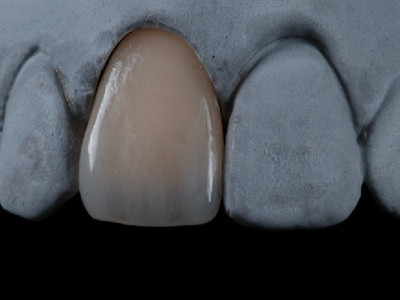The rapid development of CAD/CAM technology is every day more and more coming to the aid of orthopedic dentists and dental technicians, helping to achieve excellent results in their work. An increasing number of milling centers in our country offers services for the manufacture of zirconia frameworks. This fact undoubtedly proves the growing interest in this material.
In connection with the introduction and popularization of zirconium dioxide in dental practice, dental technicians have many questions concerning the work with fabricated scaffolds.
Of paramount importance is the correctness of the carcass design. In the instructions of manufacturers of zirconium dioxide blanks great attention is paid to the thickness of the frame and the area of the connections of crowns in bridges.
The minimum circular thickness of the frames of single crowns and bridges of 3 units of the frontal group of teeth should be 0.5 mm, along the cutting edge – 0.7 mm, the connection area – 7 mm2. Bridges with a length of 4 units with an intermediate part of 2 units: circular thickness – 0.7 mm, along the cutting edge – 1 mm, connection area – 9 mm2. In the side area, the joint area increases to 12 mm2.
The modeling of the compounds occurs mainly in the vertical direction and with a certain shift to the oral side in order to preserve the aesthetics from the vestibular side.
Dental technicians who prefer for milling to provide their own wax reproductions of the future frame, including those must adhere to these rules. Failure to comply with the criteria provided for modeling frameworks during operation may lead to their failure.
Milling centers mainly use blanks obtained by isostatic pressing in a liquid followed by sintering of the frame
After milling and removing from the workpiece, the frame is subject to primary processing, which consists in grinding the attachment points of the joints to the frame before the sintering process begins.
This process requires tremendous concentration and accuracy, since the frame, which did not pass the sintering stage, is rather fragile.
After sintering, the technician sets the frame on the model. A little earlier, this process was more laborious and time consuming due to the fact that the modeling program, while saving the file, automatically thickened the cervical area of the crown to prevent possible spalling during milling. To date, the accuracy of the settings of the milling parameters allows minimizing the thickening and, therefore, eliminate the need for a significant refinement of the frame.
On the recommendations of the manufacturers, the sintered frame is recommended to be modified in compliance with certain rules. First of all, the frame can not be overheated during processing, which may entail a change in the structure of the material, and, consequently, a decrease in the strength of the frame. Refinement is done with diamond burs and a turbine tip with water-cooled or special stones for processing zirconium at very low speeds with periodic irrigation with water in the treated area to avoid overheating.
And another feature of the refinement that affects the strength of the framework of zirconium dioxide. The joints of crowns in the bridge prosthesis cannot be categorically separated by discs.
The separation site often serves as the site for initiating frame cracks. This should also be taken into account when separating the applied ceramic mass, since separation by thickness of ceramics is not always possible without touching the frame, especially if it has the color of a future restoration.
The fracture point of the framework is characterized by the presence of a “small-hilly” fracture zone and a “smoothed” material structure in the separation zone.
Manufacturers of zirconium dioxide blanks at the final stage of the preparation of the frame for applying the ceramic material are recommended to carry out the restoration roasting of the frame after it has been refined and cleaned. But you should know that the effect of transformational hardening of microcracks inherent in this material cannot act on the separation zone.
Zirconia is a durable, highly aesthetic, biologically compatible material.
But only by observing all the rules for working with him, we will get the excellent result that patients expect from us so much.

